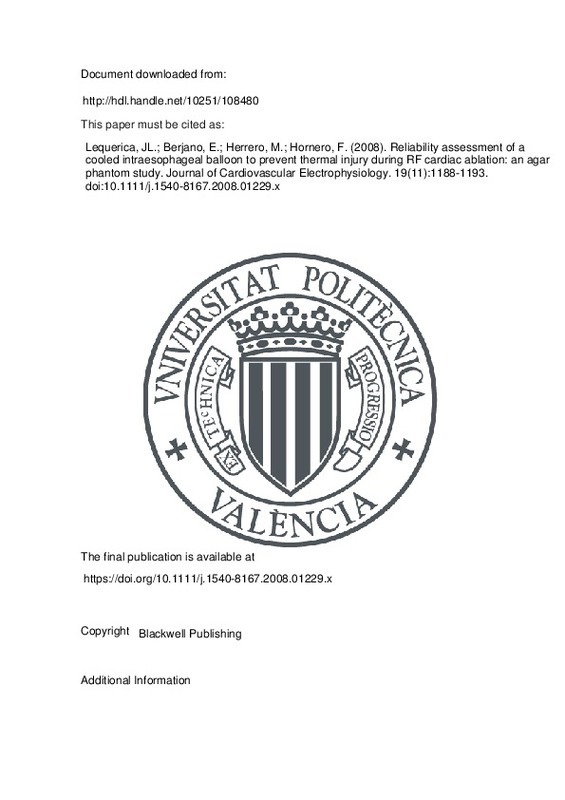JavaScript is disabled for your browser. Some features of this site may not work without it.
Buscar en RiuNet
Listar
Mi cuenta
Estadísticas
Ayuda RiuNet
Admin. UPV
Reliability assessment of a cooled intraesophageal balloon to prevent thermal injury during RF cardiac ablation: an agar phantom study
Mostrar el registro sencillo del ítem
Ficheros en el ítem
| dc.contributor.author | Lequerica, Juan L.
|
es_ES |
| dc.contributor.author | Berjano, Enrique
|
es_ES |
| dc.contributor.author | Herrero, Maria
|
es_ES |
| dc.contributor.author | Hornero, Fernando
|
es_ES |
| dc.date.accessioned | 2018-09-28T04:35:02Z | |
| dc.date.available | 2018-09-28T04:35:02Z | |
| dc.date.issued | 2008 | es_ES |
| dc.identifier.issn | 1045-3873 | es_ES |
| dc.identifier.uri | http://hdl.handle.net/10251/108480 | |
| dc.description.abstract | [EN] Cooled Balloon Prevents Thermal Injury During RF Ablation. Introduction: The use of a cooled intraesophageal balloon has recently been proposed to minimize the risk of thermal injury in the esophagus during radiofrequency (RF) ablation of the left atrium. However, the capacity of this device to adequately protect the esophagus under different procedural and anatomical conditions remains unknown. Methods and Results: An agar phantom-based model was built that provided temperature readings not only on the cooled balloon (T-b) but also at a hypothetical point between the esophageal lumen and myocardium at a distance of 2 mm (T2-mm). The RF ablations were conducted considering two anatomical factors (total distance between the electrode and balloon and flow rate around the electrode) and two procedural factors (angle and pressure between the electrode and agar surface). The results show that most of the parameters studied have no significant influence on the temperature measured on the cooled balloon (T-b), the exception being a variation in the flow rate, which was found to influence the temperature. On the other hand, T2-mm was affected to a great extent by all the factors considered, the smallest influence being that of the contact pressure. The results also suggest that when an intraesophageal balloon is employed, the applied power is not a good predictor either of the temperature on the balloon or of the temperature measured at a distance 2 mm away. Conclusion: The results suggest that a cooled intraesophageal balloon provides effective thermal protection of the esophageal lumen. However, under certain circumstances, the temperature reached at a distance 2 mm away could possibly put at risk the integrity of the inner layers of the esophagus. (J Cardiovasc Electrophysiol, Vol. 19, pp. 1188-1193, November 2008). | es_ES |
| dc.description.sponsorship | This work was partially supported by the "Plan Nacional de Investigacion Cientifica, Desarrollo e Innovaci on Tecnologica del Ministerio de Educacion y Cienciaa of Spain (TEC 2005-04199/TCM) and by an R&D contract (CSIC-20060633) between Edwards Lifescience Ltd. and the Spanish Council for Scientific Research (CSIC). | en_EN |
| dc.language | Inglés | es_ES |
| dc.publisher | Blackwell Publishing | es_ES |
| dc.relation.ispartof | Journal of Cardiovascular Electrophysiology | es_ES |
| dc.rights | Reserva de todos los derechos | es_ES |
| dc.subject | Agar model | es_ES |
| dc.subject | Atrial fibrillation | es_ES |
| dc.subject | Cooling balloon | es_ES |
| dc.subject | Esophagus | es_ES |
| dc.subject | Radiofrequency ablation | es_ES |
| dc.subject.classification | TECNOLOGIA ELECTRONICA | es_ES |
| dc.title | Reliability assessment of a cooled intraesophageal balloon to prevent thermal injury during RF cardiac ablation: an agar phantom study | es_ES |
| dc.type | Artículo | es_ES |
| dc.identifier.doi | 10.1111/j.1540-8167.2008.01229.x | es_ES |
| dc.relation.projectID | info:eu-repo/grantAgreement/MEC//TEC2005-04199/ES/MODELOS TEORICOS Y COMPUTACION AVANZADA EN EL ESTUDIO DE SEÑALES BIOELECTRICAS EN CELULAS Y TEJIDOS. IMPLICACIONES EN EL ANALISIS DE ARRITMIAS CARDIACAS, ELECTROESTIMULACION Y ABLACION POR RADIOFR.../ | es_ES |
| dc.rights.accessRights | Abierto | es_ES |
| dc.contributor.affiliation | Universitat Politècnica de València. Departamento de Ingeniería Electrónica - Departament d'Enginyeria Electrònica | es_ES |
| dc.description.bibliographicCitation | Lequerica, JL.; Berjano, E.; Herrero, M.; Hornero, F. (2008). Reliability assessment of a cooled intraesophageal balloon to prevent thermal injury during RF cardiac ablation: an agar phantom study. Journal of Cardiovascular Electrophysiology. 19(11):1188-1193. https://doi.org/10.1111/j.1540-8167.2008.01229.x | es_ES |
| dc.description.accrualMethod | S | es_ES |
| dc.relation.publisherversion | https://doi.org/10.1111/j.1540-8167.2008.01229.x | es_ES |
| dc.description.upvformatpinicio | 1188 | es_ES |
| dc.description.upvformatpfin | 1193 | es_ES |
| dc.type.version | info:eu-repo/semantics/publishedVersion | es_ES |
| dc.description.volume | 19 | es_ES |
| dc.description.issue | 11 | es_ES |
| dc.relation.pasarela | S\33613 | es_ES |
| dc.contributor.funder | Ministerio de Educación y Ciencia | es_ES |







![[Cerrado]](/themes/UPV/images/candado.png)

